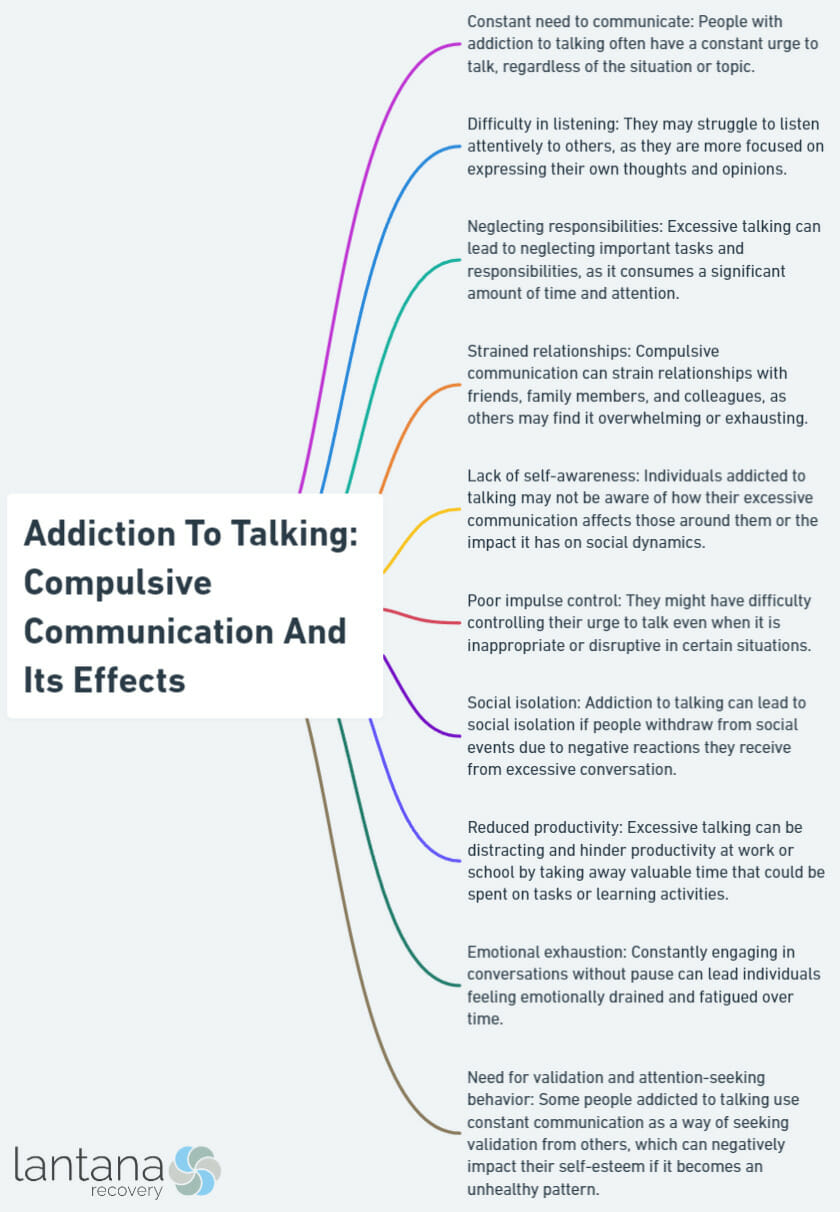Addiction to talking, also known as compulsive communication, is a psychological phenomenon in which individuals feel an irresistible urge to engage in excessive and often unnecessary talking. This behavior can adversely affect their personal and professional relationships, as well as their mental and emotional well-being.
While communication is a vital part of human interaction, addiction to talking goes beyond regular communication and becomes a compulsive need that individuals struggle to control.
The effects of addiction to talking are far-reaching. In terms of interpersonal relationships and communication, individuals with this addiction may monopolize conversations, interrupt others, and fail to listen or engage in meaningful dialogue. This can strain relationships and create feelings of frustration and alienation for both parties involved. Addiction to talking can have negative impacts on mental and emotional well-being, leading to increased stress, anxiety, and a decreased sense of self-worth.
Understanding the causes and risk factors of addiction to talk is essential in addressing and managing this issue. Underlying psychological factors, such as a need for validation, low self-esteem, or anxiety, can contribute to the development of this addiction. Social and environmental influences, such as a lack of healthy communication models or a desire for attention, can also play a role.
Recognizing the signs of addiction to talking is crucial in identifying and seeking appropriate help. Some common signs may include dominating conversations, speaking rapidly, difficulty in self-regulation, and a preoccupation with talking. It is important to note that addiction to talking can coexist with other mental health conditions, such as attention deficit hyperactivity disorder (ADHD) or bipolar disorder.
Treatment and management options for uncommon addiction to allergies or to talking typically involve therapy and counseling. Cognitive-behavioral therapy (CBT) can help individuals identify and modify the patterns of behavior that contribute to excessive talking. Support groups and peer support can also provide a safe and understanding environment for individuals to share their experiences and gain insights from others going through similar challenges.
Both individuals struggling with addiction to talking and their loved ones can benefit from coping strategies. Setting boundaries is essential to ensure healthy communication dynamics, allowing other individuals to be heard and creating balanced conversations. Active listening skills can also be cultivated to promote understanding and empathy. Encouraging healthy communication patterns, such as taking turns speaking and practicing mindfulness, can contribute to more fulfilling and balanced conversations.
By understanding the nature of addiction to talk, recognizing its effects, and implementing appropriate treatment and coping strategies, individuals can work towards managing this addiction and improving their overall well-being.

Understanding Addiction to Talking
Understanding addiction to talk helps individuals identify and address the issue effectively. Here are important factors to consider:
- Recognition: Being aware of signs of addiction to talking helps individuals understand if they have a problem. This includes dominating conversations, talking excessively, and feeling compelled to talk even when there are negative consequences.
- Impact on relationships: Addiction to talking strains relationships with friends, family, and colleagues. It affects communication dynamics and contributes to conflicts or misunderstandings.
- Psychological factors: Addiction to talking may be linked to underlying psychological factors such as low self-esteem, a need for validation, or a fear of silence. Understanding these issues is crucial in addressing addiction effectively.
- Health consequences: Excessive talking takes a toll on physical and mental well-being. It leads to exhaustion, increased stress levels, and difficulty focusing on tasks. Recognizing the impact on overall health motivates individuals to seek help.
- Treatment options: Seeking professional help through therapy or counseling is beneficial in overcoming addiction to talking. Therapists from alcohol rehab institutions provide guidance, support, and techniques to manage excessive talking.
Understanding addiction to talk is the first step toward recovery. By recognizing the signs, addressing underlying issues, and seeking appropriate help, individuals can regain control over their communication habits and improve their overall well-being.
What is Compulsive Communication?
Compulsive communication, also known as excessive talking, is driven by psychological factors. It is characterized by an overwhelming urge to talk, even when it is not necessary or appropriate. Unlike regular communication, which is used to express thoughts, compulsive communication becomes a compulsion that individuals feel compelled to engage in, regardless of its impact on themselves or others.
The effects of compulsive communication can be diverse. It can negatively impact interpersonal relationships and communication, overwhelming and irritating others. Additionally, it can lead to difficulties in maintaining meaningful connections and can result in social isolation.
Moreover, compulsive communication can have an impact on mental and emotional well-being. Individuals who engage in compulsive communication may experience stress, anxiety, and frustration when they are unable to satisfy their need to talk. This can lead to dissatisfaction and a constant urge to seek validation and attention through excessive talking.
There are several important signs of compulsive communication. These may include difficulty controlling the urge to talk, a feeling of relief or satisfaction after excessive talking, and experiencing negative consequences in relationships or daily life.
True Story: Sarah is one individual who struggled with compulsive communication. She constantly talked at work, with friends, and even with strangers. She felt a constant need to be heard and validated, but it left her feeling drained and disconnected. Through therapy and counseling, Sarah learned healthier ways to express herself and manage her need for validation. She set boundaries, actively listened to others, and cultivated healthy communication patterns. As a result, Sarah’s relationships improved, and she felt more in control of her compulsive communication tendencies.
How does Addiction to Talking Differ from Regular Communication?
Addiction to talking differs from regular communication in several ways. It involves an uncontrollable urge to engage in excessive and repetitive communication. This compulsion is difficult to control, even when it has negative consequences.
Unlike regular communication, addiction to talking is characterized by long and intense periods of talking. Individuals with this addiction may dominate conversations without considering others’ needs or interests. Regular communication involves a balance between speaking and listening, while addiction to talking tends to disregard others’ voices. This addiction can strain relationships as others may find the excessive talking overwhelming and exhausting. People with an addiction to talking may not be aware of how it affects others, while regular communication involves attentiveness to others’ responses. Addiction to talking can have detrimental effects on mental and emotional well-being, leading to feelings of isolation.
On the other hand, regular communication, when balanced and reciprocal, enhances well-being and cultivates positive relationships. Recognizing these differences is crucial in addressing addiction to talking.
Through appropriate treatment and management strategies, individuals can learn healthier and more balanced conversations. Mary’s experience with addiction to talking illustrates the transformative power of addressing this issue.
Despite her vibrant personality, Mary became isolated due to her excessive talking. With therapy and support groups, she recognized her addictive behavior and developed healthier communication habits. Active listening and setting boundaries allowed Mary to rebuild her relationships and reconnect with loved ones.
The Effects of Addiction to Talking
Discover the powerful impact of addiction to talking as we delve into the effects it has on interpersonal relationships, communication, and mental and emotional well-being.
Interpersonal Relationships and Communication
Interpersonal relationships and communication play a vital role in human interaction. Individuals who are excessively talkative may encounter challenges in establishing meaningful connections and actively listening to others. Their constant urge to talk can overpower conversations, leaving little opportunity for others to participate.
This imbalance can result in feelings of isolation and frustration among acquaintances, loved ones, and colleagues. Furthermore, perpetually talking can strain relationships as it may be perceived as self-centered and inconsiderate. Pivotal aspects of effective communication, such as empathy, may also be lacking in individuals with a talking addiction. This addiction can make it arduous to sustain friendships as others may feel unheard or insignificant.
Mental and Emotional Well-being
Addiction to talking significantly impacts the mental and emotional well-being of individuals. Here are some key aspects to consider:
1. Emotional Distress: Excessive talking leads to emotional distress, causing individuals to feel overwhelmed, anxious, or depressed. Managing these emotions becomes challenging when the need to constantly communicate becomes compulsive.
2. Relationship Strain: Addiction to talking strains interpersonal relationships. Constant talking leads to frequent interruptions, monopolization of conversations, and difficulty in listening. This results in misunderstandings, conflicts, and a lack of connection with loved ones and friends.
3. Social Isolation: Talking addiction makes it difficult to maintain healthy social interactions. The excessive need for communication pushes others away, as constant talking can be overwhelming and exhausting. This leads to a sense of isolation and loneliness.
4. Impact on Mental Health: Talking addiction has a detrimental effect on overall mental well-being. It hinders reflection, emotional processing, and engagement in self-care activities. The constant need for external validation through talking also hinders the development of internal coping mechanisms.
5. Disruption of Productivity: Excessive talking interferes with daily tasks and responsibilities, decreasing productivity and efficiency. It’s challenging to focus on work or personal goals when attention is constantly diverted.
Addressing the mental and emotional well-being of individuals struggling with addiction to talking is crucial. Seeking therapy from , support groups, and developing healthy communication patterns play a vital role in managing and overcoming this addiction, promoting better mental health and overall well-being.
Causes and Risk Factors
Unveiling the root causes and potential risks of compulsive communication, we dive into the realm of addiction to talking. Exploring the intricate interplay of underlying psychological factors and the impact of social and environmental influences, we uncover the fascinating dynamics that fuel this phenomenon.
Underlying Psychological Factors
Underlying psychological factors, such as low self-esteem, insecurity, impulsivity, emotional regulation difficulties, and feelings of loneliness and social isolation, play a significant role in addiction to talking. These factors contribute to excessive communication and make it difficult for individuals to control or stop this behavior:
1. People with low self-esteem rely on excessive talking to seek validation and approval, constantly seeking reassurance and attention, which fuels addictive behavior.
2. Feelings of insecurity and anxiety drive excessive talking as a coping mechanism. By constantly talking, individuals try to mask their insecurities or gain control over their surroundings.
3. Individuals with impulsive tendencies are prone to addiction to talking. Their urge to speak without thinking leads to excessive conversation without considering consequences or its impact on others. Lately, researchers like Marci R. Mitchell and Marc N. Potenza have been investigating impulsivity and related traits like sensation-seeking to gain a deeper understanding of their connections with addictions in their study Addiction and Personality Traits: Impulsivity and Related Constructs.
4. Some individuals struggle with regulating their emotions effectively. Excessive talking temporarily relieves intense emotions, perpetuating the addiction.
5. Feelings of loneliness and lack of connections contribute to addiction to talking. Constant communication temporarily relieves isolation and increases the chances of forming connections.
Addressing these underlying psychological factors is crucial in the treatment of addiction to talking. Therapy and counseling with us at Lantana can help develop healthier communication patterns, enhance self-esteem, and improve emotional regulation. By addressing these root causes, individuals can break free from excessive communication and foster more meaningful interactions.
Social and Environmental Influences
Social and environmental factors play a vital role in the development and perpetuation of talking addiction. It is important to take into account various key factors such as social pressure, family dynamics, underlying issues, technological influences, and work and educational environment.
- Social pressure, including peer influence and societal norms, significantly contributes to excessive talking. In a culture that highly values constant communication, individuals may feel compelled to engage in excessive talking in order to fit in.
- Family dynamics also have a significant influence on a person’s behavior in terms of communication. Growing up in an environment that encourages excessive talking can contribute to the development of addiction.
- Additionally, underlying issues like stress, loneliness, and low self-esteem can amplify the need for excessive communication. Seeking validation or escapism from personal problems can result in relying on talking as a coping mechanism.
- Technological influences, particularly social media and the constant connectivity through smartphones have magnified communication opportunities. The constant presence of platforms for talking and the pressure to maintain a digital presence can contribute to addictive talking behaviors.
- Furthermore, certain work and educational environments, such as high-pressure jobs or competitive academic settings, may require frequent communication, increasing the risk of addiction to talking. The need for constant communication and validation can be fueled by such environments.
Considering these social and environmental influences is crucial when it comes to understanding and addressing talking addiction. Recognizing and addressing the underlying factors that contribute to compulsive communication is essential in overcoming addiction and fostering healthier communication habits.
Recognizing the Signs of Addiction to Talking
Just like when dealing with other addictions like hash addiction or dependence on cannabis, recognizing the signs of addiction to talking is crucial in understanding and addressing this compulsive behavior. Here are some signs to look out for:
1. Dominating Conversations: People addicted to talking tend to dominate conversations and have difficulty allowing others to speak. They often hijack discussions and redirect the focus to themselves.
2. Inability to Stop Talking: Those addicted to talking may be unable to stop talking even when it is inappropriate or others are disinterested.
3. Talking Over Others: Interrupting and talking over others is a common sign of addiction to talking. This behavior can create tension and disrupt communication.
4. Long Monologues: Individuals with this addiction may engage in long monologues, often disregarding feedback or cues from others.
5. Neglecting Other Responsibilities: Addiction to talking can consume significant amounts of time and attention, causing individuals to neglect important responsibilities.
6. Relationship Strain: Excessive talking strains relationships, making others feel unheard or unimportant.
Recognizing these signs helps individuals acknowledge and address their addiction to talking. Seeking support from therapists, joining support groups, or practicing active listening techniques can help individuals work towards healthier and more balanced communication habits.

Treatment and Management
Addiction to talking can be a challenging issue to manage, but there are effective strategies available. In this section, we will explore the different approaches to treatment and management. From therapy and counseling with us to the support provided by support groups and peer support, we’ll uncover the options that can help individuals overcome their compulsive communication habits.
Therapy and Counseling
Therapy and counseling play a crucial role in the treatment of addiction to talking where “addictive behavior is characterized by preoccupation with the substance or the experience, withdrawal symptoms after not engaging in the substance or experience, increased tolerance for the substance or activity in order to achieve the same effect, and continued use despite negative consequences” (Substance abuse and counseling: A perspective, Sales, 1999.) It is important to consider the following aspects:
1. Professional guidance: Seeking therapy and counseling involves working with trained professionals like us at Lantana who specialize in addiction and communication disorders. These experts help individuals understand the underlying causes of their addiction and develop effective strategies to overcome it.
2. Individual therapy: One-on-one sessions provide a safe and confidential space for individuals to explore their thoughts, feelings, and behaviors related to their addiction. Therapists utilize evidence-based techniques to address the psychological factors contributing to the addiction and identify triggers for compulsive communication.
3. Cognitive-behavioral therapy (CBT): CBT is a commonly used approach to treat addiction to talking. It focuses on challenging negative thoughts and developing healthier coping mechanisms. By replacing unhealthy communication habits with constructive alternatives, individuals can learn more effective ways to express themselves.
4. Group therapy: Participating in group sessions allows individuals to connect with others facing similar challenges. This supportive environment promotes peer learning, empathy, and encouragement. It also provides an opportunity to practice healthy communication skills and receive feedback.
5. Family therapy: Involving family members in therapy is important for understanding the impact of addiction on relationships. Family therapy helps improve communication, set boundaries, and strengthen support systems.
6. Continued support: Aftercare programs and support groups are available for long-term recovery. These programs offer ongoing assistance, guidance, and encouragement to ensure individuals have the necessary support network.
While therapy and counseling are essential in addressing addiction to talking, it is important to remember that each person’s recovery journey is unique. Seeking professional help and engaging in therapy can significantly improve the chances of successful recovery and overall well-being.
True Story: Sarah, an avid communicator, sought therapy and counseling to address her addiction to talking. Through individual sessions, she discovered that her excessive communication stemmed from a fear of being misunderstood and a need for validation. Cognitive-behavioral therapy helped her challenge negative thoughts and develop healthier communication habits. Group therapy provided valuable peer support. Sarah also involved her family in therapy sessions to rebuild trust and improve communication. Over time, she gained self-awareness and learned to express herself effectively. With continued support and healthy coping strategies, Sarah successfully managed her addiction and experienced improved relationships and overall well-being.
Support Groups and Peer Support
Just like how peer support in substance use helps individuals seeking long-term recovery by creating supportive and mutual relationships that foster the initiation and continuation of their recovery journey as explored by Christian Scannell in Voices of Hope, Substance Use Per Support in a System of Care, these groups are essential for individuals struggling with addiction to talking. These groups serve as valuable resources, providing a safe and understanding environment where individuals can seek guidance, share experiences, and receive support from others facing similar challenges:
- Empathy and Understanding: Support groups offer a space where individuals can connect with others who understand the struggles and complexities of addiction to talk. Sharing experiences helps individuals feel validated and gain a sense of belonging.
- Sharing Coping Strategies: Support groups provide a platform for individuals to share effective coping strategies. This includes techniques to manage the urge to constantly talk, improve active listening skills, and cultivate healthier communication patterns.
- Accountability: Regularly attending support group meetings helps individuals establish accountability. Sharing progress, setbacks, and successes with the group motivates individuals to stay on track and continue working toward recovery.
- Learning from Others: Peer support allows individuals to learn from others who have successfully overcome addiction to talking or are in the recovery process. Hearing stories of resilience and personal growth inspires and provides hope for those seeking to change their behavior.
- Building a Support Network: Support groups and peer support enable individuals to build a network of like-minded individuals invested in their recovery journey. This network offers ongoing encouragement, guidance, and understanding throughout the recovery process.
Support groups and peer support play a pivotal role in helping individuals with addiction to talk find the necessary guidance, resources, and encouragement to overcome their challenges and develop healthier communication habits.

Coping Strategies for Individuals and Loved Ones
Setting boundaries is crucial for managing addiction to talking. By establishing clear limits, individuals can regain control over their communication patterns and work towards healthier relationships and well-being.
1. Personal boundaries: Individuals should identify their needs and limits in talking. This involves recognizing when they need alone time when they need to focus on other priorities, and when they feel overwhelmed by excessive talking. By communicating these boundaries, individuals can assert their needs and create a healthier balance in relationships.
2. Communicating boundaries: It is important to express boundaries to friends, family, and colleagues. This can be done by clearly stating personal limits, such as requesting uninterrupted work time or asking for space during certain hours of the day. By setting and communicating these boundaries, individuals can maintain healthier relationships and avoid feeling overwhelmed or controlled.
3. Consistency in boundaries: It is crucial to consistently enforce boundaries. This means valuing personal limits and not compromising them for the sake of others. By prioritizing self-care and respecting personal boundaries, individuals can cultivate a healthier approach to communication.
4. Seeking support: Individuals struggling with addiction to talking can benefit from therapists, counselors, or support groups. These resources provide guidance and strategies for setting and maintaining boundaries in relationships.
5. Self-reflection and self-awareness: By regularly reflecting on communication patterns and recognizing triggers that lead to excessive talking, individuals can become more aware of their own needs and boundaries. This self-awareness helps effectively set and enforce boundaries to manage addiction to talking.
Active Listening
Active listening is essential for effective communication. By actively listening, we can fully comprehend and engage with the speaker, cultivating meaningful connections. Here are some important aspects to consider when practicing active listening:
1. Focus: Give your complete attention to the speaker. Avoid distractions and maintain eye contact to demonstrate interest.
2. Stay Present: Be in the present moment and refrain from mentally preparing your response. Instead, concentrate on understanding the speaker’s perspective.
3. Avoid Interruptions: Allow the speaker to express their thoughts and ideas without any interruptions. Show respect for their voice and opinions.
4. Ask Questions: Seek clarity by asking open-ended questions that encourage the speaker to provide more information. This indicates attentiveness and a genuine desire to comprehend.
5. Paraphrase and Reflect: Restate or rephrase what the speaker has said to ensure accurate understanding. Reflecting on their words back to them validates their thoughts and emotions.
6. Empathy: Put yourself in the speaker’s shoes and try to understand their emotions and experiences. Show empathy and support by offering understanding and validation.
Practicing active listening creates a secure and respectful environment for open communication. It fosters trust, strengthens relationships, and enhances overall understanding. Remember, active listening is a skill that can be developed through practice and conscious effort.
Encouraging Healthy Communication Patterns
Encouraging healthy communication patterns is essential for individuals struggling with addiction to talking. By implementing the following strategies, individuals can improve their communication skills and cultivate healthier relationships:
1. Practice Active Listening: Focus on the speaker, make eye contact, and provide feedback to show understanding. This fosters empathy and mutual understanding.
2. Develop Empathy and Respect: Understand different perspectives and treat others with respect to have more constructive conversations and reduce domination.
3. Set Boundaries: Respect personal space, allow others to speak uninterrupted, and share personal experiences appropriately.
4. Resolve Conflict: Use “I” statements, active listening, and find common ground for effective conflict resolution.
5. Practice Mindful Communication: Be aware of communication patterns and emotions to promote healthier and more effective communication.
6. Seek Professional Support: Therapy and counseling with Lantana, for example, can provide valuable tools and strategies to improve communication skills.
By incorporating these strategies and seeking appropriate support from drug rehab institutions in Charleston, individuals can enhance their communication skills, build healthier relationships, and overcome their addiction to talking. Change takes time and effort, but with determination and support, positive progress can be achieved.

Frequently Asked Questions
What is compulsive talking?
Compulsive talking, also known as talkaholism, refers to the behavior of talking excessively and beyond what is considered socially acceptable. It is characterized by continuous talking or only pausing when the other person starts speaking.
What personality traits are associated with compulsive talking?
Compulsive talkers often possess assertive personality traits, including a willingness to communicate and self-perceived competence in communication. They may also exhibit neuroticism traits.
Are there specific categories of excessive talking?
Yes, there are different categories of excessive talking, including pressured speech, hyperverbal speech, disorganized speech, and compulsive talking. Each category has distinct characteristics associated with it.
How common is compulsive talking?
Studies have found that around 5.2% of university students in the United States and 4.7% of students in New Zealand exhibit talkaholic tendencies. Compulsive talking is a behavior that goes beyond social norms.
Can compulsive talking be linked to certain mental health conditions?
Answer: Yes, compulsive talking can be associated with mental health disorders such as bipolar disorder, anxiety disorders, attention deficit hyperactivity disorder (ADHD), and schizophrenia. These conditions may contribute to the development of compulsive talking behaviors.
How can one effectively manage compulsive talking?
There are self-management skills that can help manage compulsive talking, including actively listening more than speaking, paying attention to social cues, setting mental timers, and being mindful of the reward centers of the brain. Therapy options such as cognitive behavioral therapy (CBT) and dialectical behavioral therapy (DBT) can also be beneficial in treating compulsive talking.









